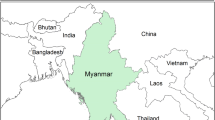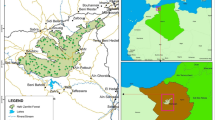Abstract
The present study used temporal remote sensing data for 1990, 2001 and 2006 to assess spatio-temporal patterns of forest cover changes in Shiwalik range of the Himalaya, Dehradun forest division. Forests are innately associated to human well-being. However, with the increasing anthropogenic activities, deforestation has increased. Quantitative change analysis of the forest cover for the past two decades provides valuable insight into the forest conservation vis-à-vis anthropogenic activities in the region. Spatio-temporal datasets along with biotic and abiotic variables provide opportunities to model the forest cover change further. The present study investigates forest cover change and predicts status of forest cover in the Dehradun forest division. Land Change Modeller (LCM) was used to predict status of forest cover for 2010 and 2015 using current disturbance scenarios. Comparing actual LULC of 2006 with the predicted LULC of 2006 validated change prediction model and agreement was 61.03%. The forested areas are getting degraded due to anthropogenic activities, but deforestation/degradation does not contribute much in expanding urban area. Agricultural areas and fallow lands are the main contributors to increased urban area. The study demonstrates the potential of geospatial tools to understand spatio-temporal forest cover change and generate the future scenarios.





Similar content being viewed by others
References
Atkinson PM, Tatanall ARK (1997) Neural networks in remote sensing. Int J Remote Sens 18(4):699–709
Banerjee A, Reddy K, Nand Paul P (2002) Application of remote sensing and GIS in demographic and socio-economic analysis of Dehradun City. Indian Cartogr MUIP-06:274–281
Busch C, Geoghengan J (2010) Labor scarcity as an underlying cause of the increasing prevalence of deforestation due to cattle pasture development in the southern Yucatan region. Reg Environ Change 10:191–203
Census of India (2001) Census data of Uttaranchal. [Online]. Available on: http://www.censusindia.net. Accessed on 10 May 2009
Chaturvedi AN (1992) History of forests in India. Indian For 118(10):729–735
Chauhan PS, Porwal MC, Sharma L, Negi JD (2003) Change detection in Sal forest in Dehradun forest division using remote sensing and geographical information system. J Indian Soc Remote Sens 31(3):211–218
Chen CTA, Liu JT, Tsuagn BJ (2004) Island based catchment—the Taiwan example. Reg Environ Change 4:39–48
Cramér H (1999) Mathematical methods of statistics. Princeton University Press, Princeton
Dadhich PN, Hanaoka S (2010). Markov method integration with multi-layer perceptron classifier for simulation of urban growth of Jaipur city. Selected topics in power systems and remote sensing, 10th WSEAS/IASME international conference on electric power systems, high voltages, electric machines (power ‘10) and 6th Wseas international conference on remote sensing (remote ‘10), Iwate Prefectural University, Japan, October 4–6, 2010, pp 118–123
Deng JS, Wang K, Hong Y, Qi JG (2009) Spatio-temporal dynamics and evolution of land use change and landscape pattern in response to rapid urbanization. Landsc Urban Plan 92(3–4):187–198
Eastman JR (2009) IDRISI Taiga, guide to GIS and remote processing. Clark University, Worcester, pp 234–256
FSI (2009) Indian State of Forest Report (ISFR) 2009. Forest Survey of India. MoEF, GOI, Dehradun, p 199
Geri F, Rocchini D, Chiarucci A (2010) Landscape metrics and topographical determinants of large-scale forest dynamics in a Mediterranean landscape. Landsc Urban Plan 95(1–2):46–53
GLCN (2009) Global land cover network. Global land cover 2000. [Online]. Available on: http://www.glcn.org. Accessed on 15 May 2009
Gren IM, Campos M (2010) Development and non-indigenous species at the global scale. Reg Environ Change. doi:10.1007/s10113-010-0183-8
Hansen MC, Stehman SV, Potapov PV, Loveland TR, Townshend JRG, DeFries R, Pittman KW, Arunawati B, Stolle F, Steininger MK, Carroll M, DimIcele C (2008) Humid tropical forest clearing from 2000 to 2005 quantified by using multitemporal and multiresolution remotely sensed data. Proc Natl Acad Sci 105:9439–9444
Hertel D, Harteveld MA, Leuschner C (2009) Conversion of a tropical forest into agroforest alters the fine root-related carbon flux to the soil. Soil Biol Biochem 41:481–490
Joshi R, Singh R (2009) Asian Elephant (Elephas maximus) and Riparian Wildlife Corridors: a case study from Lesser-Himalayan Zone of Uttarakhand. J Am Sci 4(1):63–75
Joshi PK, Gupta B, Roy PS (2008) Spectral evaluation of vegetation features using multisatellite sensor system (Terra Aster, Landsat ETM + and IRS 1D LISS III) in man made and natural landscape. Sensor Rev 28(1):52–61
Kummer DM, Tuner BL (1994) The Human causes of deforestation in Southeast Asia. Bioscience 44(5):323–328
Leimgruber P, Kelly DS, Steininger MK, Brunner J, Müller T, Songer M (2005) Forest cover change patterns in Myanmar (1990–2000). Environ Conserv 32:356–364
Lepers E, Lambin EF, Janetos AC, DeFries R, Achard F, Ramankutty N, Scholes RJ (2005) A synthesis of information on rapid land-cover change for the period 1981–2000. Bioscience 55:115–124
Lewis OT (2009) Biodiversity change and ecosystem function in tropics forests. Basic Appl Ecol 10:97–102
Lillesand TM, Kiefer RW, Chipman JW (2007) Remote sensing and image interpretation, 5th edn. Wiley India Pvt. Ltd, New Delhi
Mayaux P, Holmgren P, Achard F, Eva H, Stibig H, Branthomme A (2005) Tropical forest cover change in the 1990 s and options for future monitoring. Philos Trans R Soc B Biol Sci 360:373–384
Mücher CA, Hennekens SM, Bunce RGH, Schaminée JHJ, Schaepman ME (2009) Modelling the spatial distribution of Natura 2000 habitats across Europe. Landsc Urban Plan 9(2):148–159
Myers N (1990) The biodiversity challenge: expanded hot-spots analysis. Environmentalist 10:243–256
Nandy N, Kushwaha SPS, Dadhwal VK (2011) Forest degradation assessment in the upper catchment of the river Tons using remote sensing and GIS. Ecol Indic 11:509–513
Napton DE, Auch RF, Headley R, Taylor JK (2010) Land changes and their driving forces in the Southeastern United States. Reg Environ Change 10:37–53
Negi AK, Bhatt BP, Todaria NP, Saklani A (1997) The effect of colonialism on forest and the local people in the Garhwal Himalaya, India. Mountain Res Dev 17:159–168
NIC (2001) National Informatics Centre, Government of India, 2000–01. Dehradun district unit. [Online] Available on: http://home.nic.in/. Accessed on 1 Jan 2009
Ochoa-Gaona S, Gonzalez-Espinosa M (2000) Land use and deforestation in the highlands of Chiapas, Mexico. Appl Geogr 20:17–42
Puyravaud J (2003) Standardizing the calculation of the annual rate of deforestation. For Ecol Manag 177:593–596
Rathore SKS, Singh SP, Singh JS, Tiwari AK (1997) Changes in forest cover in a central Himalayan catchment—inadequacy of assessment based on forest area along. J Environ Manag 49:265–276
Reddy CS, Rao LRM, Pattanaik C, Joshi PK (2008) Assessment of large scale deforestation of Nawarangpur district, Orissa, India: a remote sensing based study. Environ Monit Assess. doi:10.1007/s10661-008-0400-9
Sala OE, Chapin FSI, Armesto JJ, Berlow E, Bloomfield J, Dirzo R, Sanwald EH, Huenneke LF, Jackson RB, Kinzig A, Leemans R, Lodge DM, Mooney HA, Oesterheld M, Poff NL, Sykes MT, Walker BH, Walker M, Wall DH (2000) Global biodiversity scenarios for the year 2100. Science 287:1770–1773
Sapkota IP, Tigabu M, Oden PC (2009) Species diversity and regeneration of old-growth seasonally dry Shroea robusta forest following gap function. J For Res 20(1):7–14
Semwal RL, Nautiyal S, Sen KK, Rana U, Maikhuri RK, Rao KS, Saxena KG (2004) Patterns and ecological implications of agricultural land-use changes: a case study from Central Himalaya, India. Agric Ecosyst Environ 102:81–92
Sen KK, Semwal RL, Rana U, Nautiyal S, Maikhuri RK, Rao KS, Saxena KG (2002) Patterns and implications of land use/cover change: a case study in Pranmati watershed (Garhwal Himalaya, India). Mountain Res Dev 22:56–62
Singh R (1995) Urbanization in Garhwal Himalaya. M.D. Publication Pvt Ltd, New Delhi
Singh JS, Pandey U, Tiwari AK (1984) Man and Forests: a Central Himalayan case study. Ambio 13:80–87
Tucker RP (1982) The forest of Western Himalayas: the legacy of British colonial administration. J For Hist 26(3):112–122
Tucker RP (1984) The historical context of social forestry in the Kumaon Himalayas. J Dev Area 8:341–356
Tucker CJ, Townshend JRG (2000) Strategies for monitoring tropical deforestation using satellite data. Int J Remote Sens 2:1461–1471
Author information
Authors and Affiliations
Corresponding author
Rights and permissions
About this article
Cite this article
Munsi, M., Areendran, G. & Joshi, P.K. Modeling spatio-temporal change patterns of forest cover: a case study from the Himalayan foothills (India). Reg Environ Change 12, 619–632 (2012). https://doi.org/10.1007/s10113-011-0272-3
Received:
Accepted:
Published:
Issue Date:
DOI: https://doi.org/10.1007/s10113-011-0272-3




